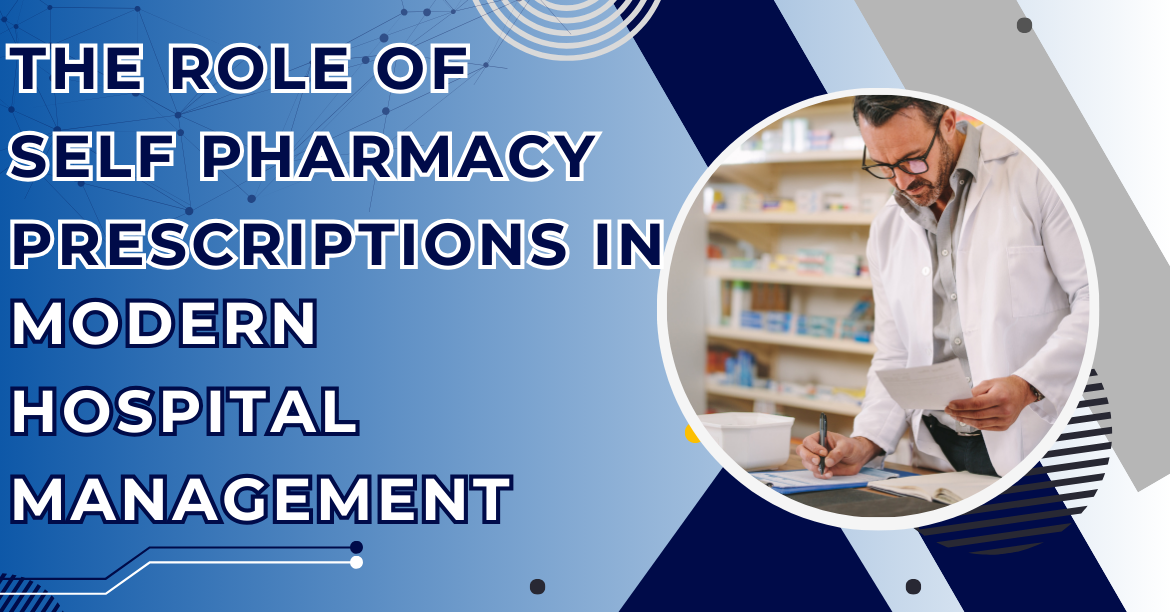


The integration of pharmacy modules is only one of the many services that hospital management software has grown to support in today's fast-paced healthcare environment. The advent of prescription systems for self-pharmacy is one of the most noteworthy developments. By allowing patients to handle their prescriptions within hospital networks and guaranteeing smooth, accurate service, these solutions provide patients more autonomy. Let's examine self-pharmacy prescriptions' function, effects on contemporary hospital administration, and reasons for hospitals implementing this technology.

Hospital prescription processing was traditionally done through drawn-out procedures. Doctors would write a prescription, which the patient would pick up from the drugstore. Although practical, this method has drawbacks. Waiting periods, manual labor, and the possibility of misunderstandings between the pharmacist and the prescribing doctor were all involved.
Self-pharmacy prescriptions, which are integrated with hospital administration systems, simplify this procedure by enabling patients to take care of their medications via hospital systems. This technology offers increased efficiency and lowers pharmaceutical handling errors, which benefits patients, pharmacies, and hospitals equally. Here are a few factors that are causing this change.
Prescriptions for self-pharmacy avoid the requirement for paper prescriptions and pharmacist manual data entry, which lowers the risk of mistakes resulting from misread handwriting or inaccurate data entry. Prescriptions from patients are sent straight to the hospital pharmacy via digital records, cutting down on delays. Without having to deal with paper documentation, patients may conveniently receive their drugs, and the hospital pharmacy is instantly updated with real-time patient data.
By involving patients in the prescription management process, self-pharmacy systems enhance patient engagement. With access to their medication records via an app or web portal, patients can check dosage instructions, refill prescriptions, or view their treatment history. This autonomy encourages better adherence to prescribed treatments and helps patients feel more in control of their healthcare.
The pharmacy module is easily integrated with other departments, such as billing, medical records, and patient administration, using contemporary hospital management software. When a doctor writes a prescription, the pharmacy has immediate access to it, which saves time and guarantees that patients can pick up their medications when needed. Integration also makes it possible to track medicine inventories more precisely, which cuts down on waste and guarantees that pharmacies always have enough inventory.
Prescriptions for self-pharmacy help hospitals stay cost-efficient. Hospitals can cut down on the amount of administrative staff needed to handle paperwork by automating the prescription procedure. Additionally, by automating certain tasks, the possibility of mistakes being made—like giving the erroneous prescription—is reduced. In order to run their facilities more sustainably, hospitals should also cut back on the quantity of physical prescriptions they print.
Patient safety is one of the most important advantages of self-pharmacy medications. When distributing medication, automation helps lower the possibility of human error. Potential problems like drug interactions, allergies, or contraindications are highlighted by the software because prescriptions are processed directly through the hospital system. This guarantees that patients receive appropriate and safe care by prompting the pharmacist or doctor to evaluate the prescription before it is filled.
Patients may more easily manage their prescriptions from any location with the help of self-pharmacy prescription systems. Using their computers or cellphones, patients can check their medication history, seek prescription refills, and receive updates on new medications that are available. Patients with long wait times at hospital pharmacies or those with chronic diseases who may require frequent medicine refills will find this convenience very helpful.
The use of digital systems allows pharmacies within hospitals to track prescriptions more effectively. This includes knowing which medications are frequently prescribed, what stock is available, and when restocking is necessary. Automated inventory management reduces the likelihood of running out of essential medications and allows pharmacies to respond faster to patient needs.
Hospitals choosing to implement self-pharmacy prescriptions are opting for efficiency, patient safety, and long-term cost savings. These systems allow healthcare facilities to streamline operations, improve patient engagement, and offer a higher level of personalized care. Moreover, patients are more likely to follow their treatment plans when they have easy access to their prescriptions and can manage refills independently.
With the increasing reliance on digital systems in hospital management, self-pharmacy prescriptions are becoming a cornerstone of efficient healthcare delivery. Hospitals adopting this technology are not only modernizing their operations but also creating an environment where patient care is seamless, efficient, and secure.
Through combining pharmaceutical services with hospital administration software, manual processes are removed, errors are decreased, and departmental communication is enhanced. This is how it improves the efficiency of workflow:
Diminished Human Errors: The software reduces human error in the prescription-to-dispensation process by automating it. Pharmacists no longer have to enter data into invoicing systems by hand or rely on handwritten prescriptions. Rather, prescriptions are sent to the pharmacy module automatically, guaranteeing that the right drug is given out.
Prescriptions for self-pharmacy are a crucial component of contemporary hospital administration systems. Hospitals can benefit from an advanced solution for better healthcare delivery by saving money, improving safety, promoting patient involvement, and expediting the prescription process. Hospital pharmacy services will be significantly shaped by self-pharmacy prescription systems as long as hospitals keep innovating and improving their patient care models.